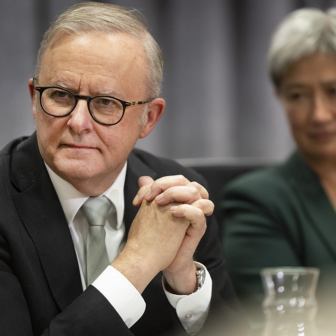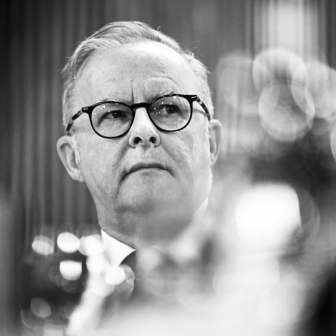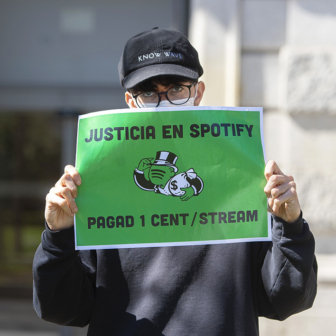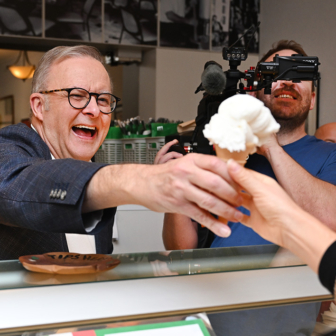There really do seem to be two election campaigns going on in Australia at the moment. Or, rather, there are two vantage points from which the ordinary punter can view what is happening.
There is the campaign you see via the mainstream media: on radio news and talkback; on television, still dominated by free-to-air channels; and in “legacy” newspapers, now commonly consulted via the web unless you’re taking a flight and have picked up a freebie. Through this lens, the campaign is a familiar-enough beast: indeed, in outward appearance, it hasn’t changed all that much in recent decades.
The candidates, along with a kind of mobile press gallery, travel here and there on buses and planes. Press conferences are held, high-vis vests are donned, streets are walked, hospitals, schools, pubs and shopping malls are visited. The selfies are a gesture to modern times, but the essential rituals would be recognisable to, say, a party leader from the 1970s. Having come back from a desert island, they might wonder what happened to Kerry Packer and the Bulletin, but the outlines would be more or less recognisable.
The second vantage point intersects with the mainstream media in all kinds of ways, but it also has a more or less independent existence. This is the campaign on social media. I don’t mean the formal campaigning that parties and other groups run via Twitter, Facebook and other platforms. Rather, I mean the more informal exchanges between journalists, politicians and ordinary citizens. I am thinking especially of Twitter.
Twitter is both a democratic and a hierarchical medium of exchange. It is more democratic than old media in its lack of filters. Within the laws of defamation and the rules of Twitter itself, you can say whatever you like. It is a cross between the letters page of a newspaper and a toilet wall, with many features of the latter because no editors are selecting, editing and curating contributions. And sometimes neither the spelling nor the grammar are all that great.
But Twitter is also deeply hierarchical. Those with large numbers of followers have much more clout and status. Celebrity types will chat amiably with one another in public while ignoring the great unwashed. The medium has its “influencers,” those who, through their prestige and reach, are considered capable of shaping the tastes, opinions or behaviour of tens of thousands while the rest of us struggle to influence our kids to put down their mobile devices for a while and read a book.
Journalists themselves have a liminal status in this world. Most of them have much more capacity than the rest of us to attract followers. This is a fascinating and under-recognised way for the legacy media — especially the newspapers — to continue to exercise a wider influence over politics and culture. Here, even journalists of the third or fourth rank can have many thousands of Twitter followers, while those who have achieved a genuine celebrity status might have 100,000 or more.
A few examples will suffice. Leigh Sales, who presents the ABC’s 7.30, has 367,000 followers; 7.30 itself has just 162,000. Laura Tingle, also of 7.30, has 115,000 followers. Barrie Cassidy’s 130,000 is more than double that of the program he hosts, the ABC’s Insiders. Annabel Crabb, another ABC television personality, has a remarkable 480,000 followers; interestingly, her stock-in-trade is presenting the more civil and human side of our politicians. Leading Radio National presenters Fran Kelly (76,000), Patricia Karvelas (51,000) and Phillip Adams (35,000) are also popular Twitter identities.
At the commercials, the picture is pretty similar. Chris Uhlmann, formerly of the ABC and now political editor of Nine News, has 151,000 followers, David Speers at Sky 113,000 and Phillip Coorey at the Australian Financial Review 106,000. Nor do you have to work for a large media company if you have the profile, prestige and respect built up over the decades to help you along. Michelle Grattan (the Conversation) and Paul Bongiorno (the Saturday Paper) have well over 100,000 followers each.
In Murdochland, Chris Kenny of the Australian and Sky, who pops up frequently on Twitter if only to criticise it, is approaching 40,000. Miranda Devine of the tabloid Daily Telegraph has over 60,000 followers, and Sharri Markson, of the same paper, about half that number. But lower-profile journalists for publications such as the Australian, the Australian Financial Review, the Sydney Morning Herald and the Age — those who would not normally be recognised in the street — will pick up 8000 to 16,000 followers if they are active on the platform. Old hands, such as Paul Kelly, can afford to stay off it entirely.
What does all of this mean? First, a number of journalists have been able to leverage a celebrity status of sorts in a way available to few others — with the notable exception of the politicians themselves. There was a time when very few journalists achieved anything like this kind of profile: think Alan Reid, Alan Ramsey, Paul Kelly, Michelle Grattan and Laurie Oakes.
Individual journalists have their own brand that is connected with, but also independent of, the media company for which they work. A good illustration of the phenomenon is Mike Carlton, who has not for some time worked for a major media company, and yet has 122,000 followers (and a very active account). When journalists cease to work for a big concern, they take their followers with them. Samantha Maiden, formerly of the Daily Telegraph and Sky, has over 100,000 followers, surely an asset for the smaller online outfit, the New Daily, that now employs her.
This is the upside for your average journalist. You can use the platform to build up individual profile, draw attention to your own stories, disseminate opinion, promote a book, and bond with or abuse other members of your craft. Journalists also sometimes draw on Twitter for material and sources. But there is a downside, too.
Best known is the abuse and trolling. Journalists are not the only targets, of course, but they are vulnerable to it, especially if they are also female. There’s a lot of hate out there in the age of Trump. This abuse can be vicious and frightening.
But Twitter also discomforts journalists in other ways. It allows their readers to provide a running commentary on their performance. And it is easy enough to see why this might be so frustrating.
This is an industry in what now seems to be a permanent state of crisis. It is struggling to evolve a business model that will preserve what’s most important in journalism while also turning a profit. The elite might be well paid and secure, but life is harder for others, some of whom are churning out thousands of words a week while shouty op-ed columnists, who don’t have to chase stories or even get basic facts right, attract the fame and the money.
Journalists were on the receiving end of a Twitter pile-on during the Barnaby Joyce affair of 2018, when many tweeters came round to the view that mainstream reporters had conspired to keep the matter under wraps. Certainly, some aspects of the matter had done the rounds on Twitter and on some small independent news sites well before the Daily Telegraph’s front-page story announced open season. But this pattern was not unusual even before the age of the internet and social media. Britain’s Profumo affair of 1963 — the most famous political sex scandal of them all — came to light in a low-circulation Westminster newsletter before it made its way into the headlines of newspapers around the world.
The present election campaign is generating similar complaints. The recent focus has been on “Watergate,” a controversy about the sale of water to the government by a company registered in the Cayman Islands with which energy minister Angus Taylor has had a previous association. Taylor’s evasive answers to questioning about the matter have not helped his or the government’s case that there is nothing to see here. The frequent complaint on Twitter is that mainstream media have shown insufficient interest in the matter. This is part of a more general complaint that Scott Morrison is getting an easy run from the media than Bill Shorten is, and that the media concerns itself with campaign trivia rather than policy substance.
Such complaints are sometimes misplaced. Individual journalists receive criticism for what is seen as a wider failing of the media as a whole. Critics can have precious little understanding of defamation law, the code of ethics, the need for careful corroboration, or the constraints of time and resources. Journalists on the prime minister’s campaign bus have been condemned for being co-opted, rather as journalists in the press gallery are often seen to be too close to politicians and their staffers — as if it were not the very function of the gallery to facilitate such contact. Patricia Karvelas was even criticised for receiving a text message from Barnaby Joyce while she was on Insiders, as if there was something sinister about a politician having the mobile number of a journalist and vice versa.
All the same, it is absurd for journalists to take the substantial benefits from a platform like Twitter while making too much of the brickbats. There is nothing more ridiculous than a high-profile figure with thousands of followers using Twitter to ridicule Twitter — for instance, as unrepresentative of wider bodies of opinion, or as notably lacking in consistency or self-awareness (failings not unknown in politics and journalism).
I’m not sure, either, why anyone should expect a toning down of partisanship on social media, least of all in an election campaign. We might all like more civility, as well as a greater willingness to see the strengths in one another’s arguments. But we also need to be realistic about how much of this we are going to get. There is already too little civility in public discourse more generally, as well as a declining respect for either evidence or expertise, including among some who call themselves journalists.
Appearances matter. Media defensiveness can come across as condescending and elitist. The ordinary camaraderie among fellow members of a profession can, to an outsider, look masonic. (We academics understand this only too well — journalists have even been known to resort to intemperate abuse of dwellers in the ivory tower.) Ordinary human feeling between journalists, politicians and staffers who share a workplace can look like an exclusive and insular club, especially when accompanied by the use of matey nicknames.
But if you are going to accept the celebrity status, however minor, and the pleasures and benefits that come with it — the show on which many of them appear is called Insiders, for God’s sake — best be aware that you might be seen by those outside the tent as a little too cosily placed within it. And the reality is that some journalists are indeed too cosy in there. A few are essentially players rather than analysts, enjoying their role in factional power plays and making their reputations by publishing the titbits provided by their “contacts” who then deploy their stories as guided missiles in party warfare.
Public suspicion is hardly surprising at a time when research tells us that people’s trust in politics and politicians is at a very low ebb. The state of the media as a whole — quite apart from the actions of any individual journalist — has given ordinary voters good reason to be suspicious. The Nine–Fairfax merger brings a former federal Coalition treasurer to the chairmanship of the board of the combined company. News Corp no longer even feigns fairness or balance and is campaigning aggressively for the Coalition. Stories circulate about the role of media magnates in the overthrow of Malcolm Turnbull. And the ABC has been subjected to a bitter and unrelenting campaign of intimidation by the government, supported by the ever-helpful Murdoch press. Ordinary citizens can be forgiven for thinking that there is now more minding of p’s and q’s than is healthy in a public broadcaster.
Twitter has changed the landscape for political reporting, and this is something that journalists have to suck up, whether they like it or not. That — or stay off the platform entirely, an option very few have so far shown any inclination to take up. If journalists want the profile that Twitter both delivers and measures, they have to deal with the reality that they will not always be showered with empathy or understanding, let alone the bouquets of an adoring public. Democracy has many virtues — including its premium on freedom of expression — but no one has ever claimed that it is always fair. •




